The FAA Written Exam... And A Long Cross-Country!
by ANN Managing Editor Rob Finfrock
I'll be honest -- when I awoke the morning of Friday, March 28,
a part of me hoped the weather would sock us in at Haller... so my
instructor, Jim Crone, and I wouldn't be able to fly over to St.
Augustine that morning, for me to take the FAA Written Exam for
sport pilot. But the dense, low-lying fog common in the early
morning hours at 7FL4 was already lifting by 8:00 am.
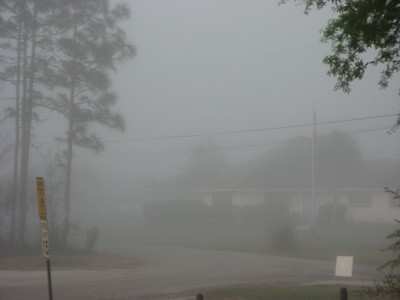
The test was scheduled for 10:00; Jim already had the plane
pulled out of the hangar when I walked outside at 8:45 am. "It's a
beautiful morning!" he exclaimed, gesturing at the high cloud
layer.
As I preflighted the Gobosh, my thoughts were admittedly
distracted somewhat from the task at hand. It would be
ironic, I thought, for me to have come this far... only to
bomb the written. Of course, I didn't really expect to do
that; in fact, I felt very well-prepared, especially after Jim had
spent a good part of the day before quizzing me. "You're definitely
ready," he told me as he signed my endorsement for the test.
N702GB fairly leapt into the air just after 9:00 am, after a
short ground roll from Haller's well-maintained grass airstrip. My
takeoff had been straight and true; Jim's earlier advice on how to
handle the Gobosh's strong left-turning tendencies on takeoff had
worked wonders, and those lessons had stuck in the time since.
Additionally, I'd spent the better part of our dual lesson Thursday
morning at Palatka repeating the "bounce-and-go" technique for
holding the proper nose attitude on landing.
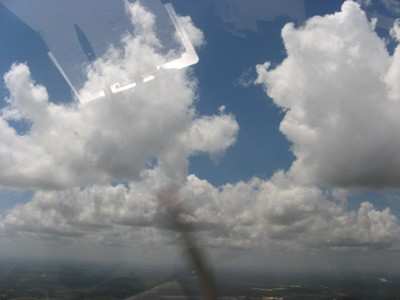
I was finally starting to feel a sense of mastery of the
Gobosh's quirks on takeoff and landing... and it felt good.
It felt odd to turn an easterly heading from Haller, instead of
tracking straight south for Palatka. Our flight to St. Augustine
would be a short one, barely longer than 15 minutes or so... but
Jim was determined to make it a teaching flight, and not simply a
short hop.
"We've got the St. Augustine VOR," he told me, dialing in 109.4
on the nav radio. "Now turn the VOR to our course, which we
computed to be 082." I did so, and was buoyed to see the radial
approach close to center, indicating I was just slightly right of
course. I banked ever-so-slightly to the left to bring us in
line.
At 10 miles out, I called up the St. Augustine tower to let them
know we were inbound. "Light Sport 702-Golf-Bravo, continue
inbound, report right base for 13," the controller replied
quickly.
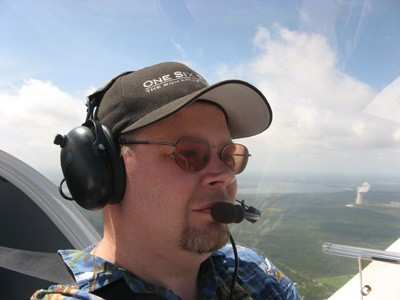
As it was still somewhat early in the morning, traffic was
relatively light. Jim, who'd flown over to SGJ Wednesday afternoon
to meet with family visiting the city, had cautioned me St.
Augustine was a very busy airport, heavy with a mix of student and
transient traffic, aerobatic trainers, and -- at the time -- even
the odd Skybus flight.
Nevertheless, our path to landing was clear, and we were on the
ground by 9:20 am. "Time to knuckle down," I said nervously, after
shutting down on the ramp at Galaxy Aviation.
 "You'll do fine," Jim
replied.
"You'll do fine," Jim
replied.
And I did. The check-in process for the exam was quick, leaving
me 30 minutes to contemplate the task ahead. Several other students
were also present at the testing center, all looking over their
course materials. Bits of loud conversation indicated most of the
students were there to take their commercial exams.
I was seated at the computer right at 10 am. The test itself
passed in a blur... I think I spent 15 minutes going through the
questions, and another 10 or so reviewing my answers. I only
skipped one question the first time around -- one having to do with
formation flight over congested areas, that was worded differently
than I'd seen it before.
I second-guessed my original answer... and got it wrong, along
with three others. That was still good enough for a 90 percent, and
the examiner congratulated me for passing the test with such a high
score. But I'd been shooting for a 96... so it was with a mixture
of relief, accomplishment, and disappointment I walked back out to
the lobby, with the test results in my hand.
"That's a great score!" Jim told me. He then chuckled a bit when
he saw the exasperated look on my face.
We spent a little time milling around the airport, before
walking back out to the ramp to head back to Haller. The lineman
graciously smiled when we told him we didn't need any fuel, and
even took the time to snap a few pictures of Jim and I with the
Gobosh.
By the time we taxied out for departure, traffic at St.
Augustine had picked up considerably. After our run-up at the end
of 13 at Bravo-1, I called the tower for departure; there was no
response to us, as the controller was too busy giving instructions
for three other planes on approach to land.
After 30 seconds passed, I asked if I should repeat my call...
mindful that I didn't want to further congest what was obviously a
busy frequency. "Give it a little more time," Jim replied. "I'm
fairly sure he knows we're here."
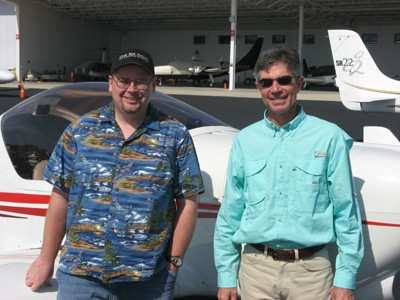
I watched as an Extra 300 taxied up for departure, across the
runway from us at A2. The controller failed to answer that pilot's
call-up, as well.
Right after the second of those three planes that had been on
approach passed over the threshold in front of us, though, the
tower's instructions came quick. "Light sport two-golf-bravo,
position and hold. Be ready to go, traffic on two-mile final...
Extra XXX, hold short for landing traffic, we'll get you out of
here right after."
We were cleared for takeoff just as I turned onto the
centerline. I probably brought the throttle in a little quicker
than I needed to, in the interest of not being rear-ended by the
landing traffic... but, of course, the resulting kick of power
veered us to the left a bit, though I was ready on the right rudder
so we didn't deviate too far from center.
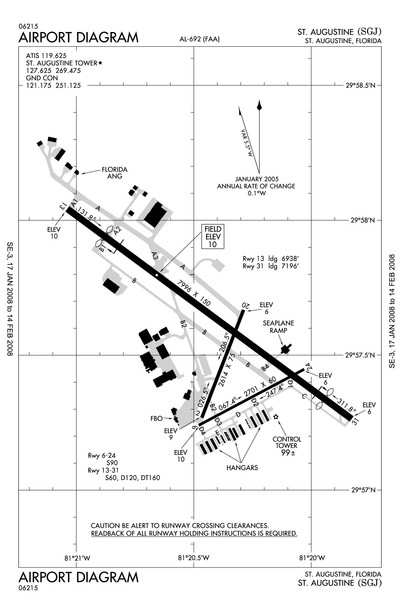
On the trip back to Haller, Jim and discussed the plan for the
remainder of the day. With the weekend approaching, Jim needed to
return home to Punta Gorda so he could instruct his regular
students there. He invited me to accompany him on the flight there
and back, in the interest of getting some cross-country time under
my belt.
"Gee... more flying?" I asked, before thanking him for his offer
and accepting it.
Time To GO Somewhere!
We set a target departure time of 3:30 pm, giving me some time
to catch up on writing for ANN. That also gave me time to plot our
course from Haller to Charlotte County Regional Airport... for the
first time, putting my recently-acquired knowledge of how to use my
E6B and plotter to the test. I commandeered a large table to spread
out my sectional chart on, tools and pencil in hand.
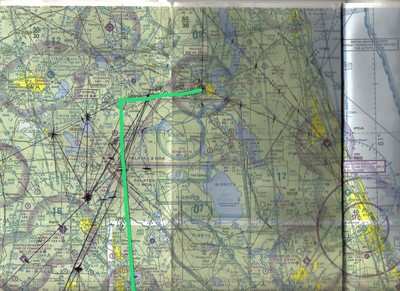
Following a stop at Palatka for fuel, a straight course would
have been best... but a sizable MOA just south of 28J ruled that
out. I wound up plotting a course that tracked a major highway west
of the field before turning south-southeast at the end of a
distinctive lake that also dog-legged to the south, followed by a
slight turn SSW once we were south of Plant City, abeam
Lakeland.
The resulting course would keep us out of the MOA (we'd skirt
under a portion of it at 2,000 feet) and would allow us to "thread
the needle" between the Class B airspace rings surrounding Tampa
and Orlando. As we were flying over Florida, there was no shortage
of identifiable checkpoints; I plotted one about every 15 miles, a
mix of lakes, large buildings and industrial plants noted on the
sectional, two large highways, and other airports. To impress Jim,
I even plotted a virtual checkpoint, shooting a radial off the
Tampa VOR that intercepted our course.
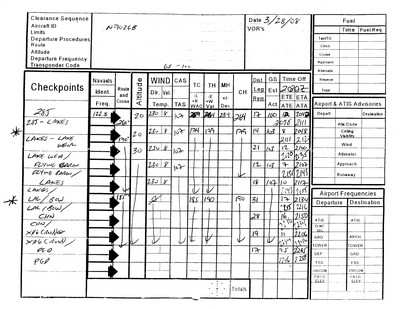
After Jim looked over my flight plan and approved it, a call to
Flight Service -- my first one ever -- gave me my winds aloft
information. I got through to a local briefer quickly, and he was
very polite and patient in dealing with a student pilot. Things
were going to be a bit bumpy at 3,000 feet -- our altitude once we
cleared the Palatka MOAs -- but we'd be rewarded with a fairly
substantial tailwind once we headed south. Despite the fact the
skies had turned gray in the time since we'd returned back to
Haller, the lowest ceilings reported along our route were 6,000
feet, scattered to broken, with nary a rain shower in sight.
"You should have a great flight," the briefer told me. "I hope
you and your instructor have fun!"
After packing the bare essentials for a weekend trip -- just one
change of clothes, and only vital toiletries -- into my Jepp bag,
Jim and I took off from Haller at 3:25 pm. We filled the Gobosh's
tank as full as we dared at Palatka, giving us well over two hours
of flying time, plus reserve.

We took off from 28J at 4:40. I could tell we were at gross
weight, as the Gobosh was ever-so-slighty more reluctant to take
flight than it had been before. As predicted, it was a bumpy ride
for the first hour or so, though not overwhelmingly so.
I'm happy to report my course proved accurate to within about
four minutes at each checkpoint. Alas, predictions of a tailwind
proved to be optimistic, and the moment we turned south it even
became a slight headwind. We indicated around 95 knots IAS the
entire trip (I'd plotted the trip at 100) -- hardly
earth-shattering, but neither Jim nor I minded very much. About
halfway to Plant City, I even -- finally -- allowed myself to
relax, and enjoy the trip.
"See how much fun it is to actually GO somewhere?" Jim
asked me. And it was.
We touched down at Punta Gorda just before 7 o'clock, for a
total flight time of 2.2 hours -- that headwind hadn't helped
matters. I made one of my best landings to date, a fitting end to
what had been a fantastic trip.
Coming Tuesday: Heading Back Home... And Dealing With The
Ides Of March
 ANN's Daily Aero-Linx (04.13.24)
ANN's Daily Aero-Linx (04.13.24) ANN's Daily Aero-Term (04.13.24): Beyond Visual Line Of Sight (BVLOS)
ANN's Daily Aero-Term (04.13.24): Beyond Visual Line Of Sight (BVLOS) Airborne 04.09.24: SnF24!, Piper-DeltaHawk!, Fisher Update, Junkers
Airborne 04.09.24: SnF24!, Piper-DeltaHawk!, Fisher Update, Junkers Aero-News: Quote of the Day (04.14.24)
Aero-News: Quote of the Day (04.14.24) ANN's Daily Aero-Term (04.14.24): Maximum Authorized Altitude
ANN's Daily Aero-Term (04.14.24): Maximum Authorized Altitude











